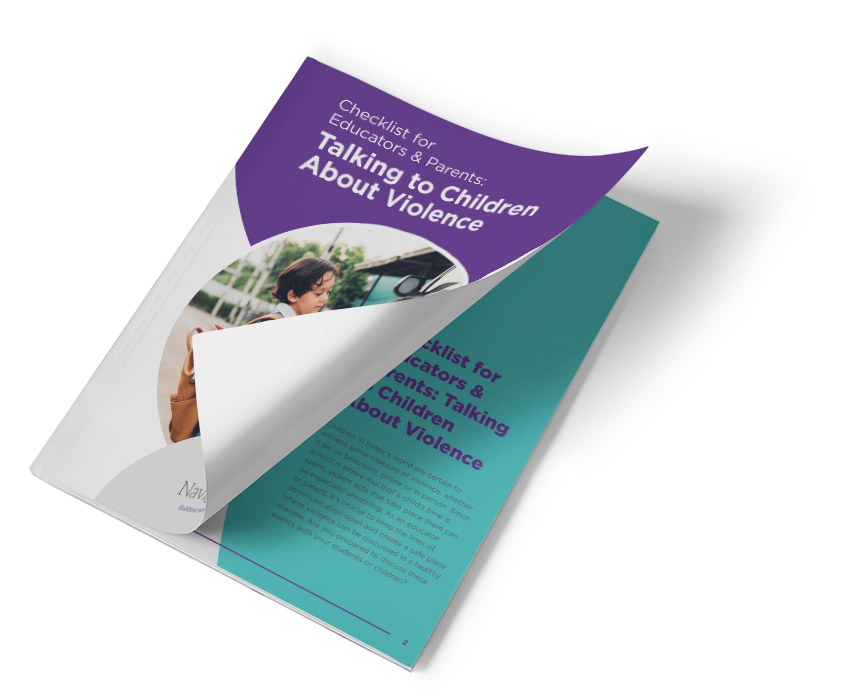CHECKLIST FOR EDUCATORS & PARENTS
Talking to Children About Violence
Children in today’s world are certain to witness some measure of violence, whether it be on television, online or in person. Since school is where much of a child’s time is spent, violent acts that take place there can be especially unsettling. As an educator or parent, it’s crucial to keep the lines of communication open and create a safe place where violence can be discussed in a healthy manner. Are you prepared to discuss these events with your students or children?
The National Association of School Psychologists (NASP) and the American Psychological Association (APA) provide helpful guidelines to educators and parents who are seeking to discuss violence with children in a healthy and helpful way. Before sparking a conversation with a child, keep this checklist in mind:
- Assure the child they are safe. Emphasize the fact that schools put measures in place to keep students safe and discuss what steps are being taken to ensure the child’s safety in the classroom. Parents may need to reiterate that home is a safe space as well. It’s also a good idea to touch on the possibility of something bad happening versus the probability that it will.
- Set aside time to talk and be patient. It may take a while for a child to feel comfortable discussing events and verbalizing his or her true feelings, which is why making time in your schedule for healthy conversations is important. Look for cues that the child is ready to talk, such as if they are hovering around while you are completing routine tasks. As always, patience is key.
- Be mindful of the child’s developmental age when discussing violence. There are many factors that influence how a child processes trauma, including age. Here are a few age-associated guidelines to consider when discussing violence with a child:
- Early elementary age – Keep conversations brief, simple and straightforward. Continually remind the child they are safe, providing general examples of what security measures are in place at school and/or home.
- Late elementary and early middle school age – The child will likely ask multiple questions, so remember to provide simple yet honest answers. Give specific examples of home or school safety measures and focus on separating misconceptions and fantasies from reality.
- Late middle school and high school age – Be prepared for the child to have strong opinions on school violence and other societal issues. Encourage them to actively play a part in their own safety by reporting strangers on school grounds and sharing any personal safety concerns they have with school personnel.
- Review home or school safety procedures to help the child feel prepared and empowered. Discuss how the child can be proactive and encourage them to feel empowered by reviewing what procedures they should follow in the event of a violent incident at school or home. Additionally, identify a trusted adult they can turn to in an emergency in both settings.
Free Checklist & Guide
Download the Complete Checklist and Guide
This comprehensive guide and useful checklist will provide important tools when talking to children after a violent incident.
Other Tips for Parents & Educators
Holding healthy conversations isn’t the only way to help children recover from witnessing or experiencing a
violent incident. Educators and parents should also take these recommendations into consideration:
- Limit exposure to news outlets at home and at school. If possible, keep televisions set on
channels that don’t show news coverage of violent or distressing events. Some news stories involve
distressing information that can trigger feelings of anxiety or confusion. Additionally, some young children
may believe the events are occurring each time footage is shown. - Keep a normal routine. Maintaining a regular schedule at school and at home can help
re-establish a sense of normalcy after a violent or stressful incident. - Take note of the child’s emotional state. Keep an eye out for unusual changes in appetite,
behavior and sleep patterns. If something seems off or if the child’s emotional state does not improve after
a few weeks, reach out to a mental health professional such as a school counselor or psychologist. - Learn the warning signs. It’s also important to refer to a mental health professional if
the child consistently displays signs of anxiety or depression, which can include:- Headaches or stomachaches
- Trouble falling asleep or staying asleep
- Nightmares
- Poor performance in school
- Excessive worry
- Avoidance of school
- Changes in behavior towards friends or other students
- Loss of interest in activities they used to enjoy
How Navigate360 Can Help
Navigate360 is here to help your school recover following violent critical incidents. Speak with a member of our team about how we can assist students, schools and families by filling out this form or calling 330-661-0106.

